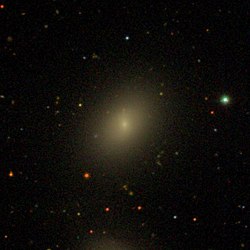NGC 4306
Appearance
| NGC4306 | |
|---|---|
 SDSSimage of NGC 4306. | |
| Observation data (J2000epoch) | |
| Constellation | Virgo |
| Right ascension | 12h22m04.1s[1] |
| Declination | 12° 47′ 15″[1] |
| Redshift | 0.006608[1] |
| Heliocentric radial velocity | 1981 km/s[1] |
| Distance | 103Mly(31.6Mpc)[1] |
| Apparent magnitude(V) | 13.8[1] |
| Characteristics | |
| Type | SB0^0(s)[1] |
| Size | ~23,000ly(7kpc) (estimated)[1] |
| Apparent size(V) | 1.50 x 1.02[1] |
| Other designations | |
| UGC 07433, VCC 0523, PGC 040032, MCG +02-32-014[1] | |
NGC 4306is adwarf[2][3][4]barred lenticular galaxylocated about 100 millionlight-yearsaway[5]in the constellationVirgo.The galaxy was discovered by astronomerHeinrich d'Arreston April 16, 1865.[6]Although considered to be a member of theVirgo Cluster,[4][7]its high radial velocity and similar distance asNGC 4305suggest that NGC 4306 is a background galaxy.[8]NGC 4306 is a companion ofNGC 4305[8]and appears to be interacting with it.[9][10]
References
[edit]- ^abcdefghij"NASA/IPAC Extragalactic Database".Results for NGC 4306.Retrieved2019-08-11.
- ^Vazdekis, A.; Peletier, R. F.; Gorgas, J.; Cenarro, A. J.; Cardiel, N.; Balcells, M.; Aragon-Salamanca, A.; Whiley, I. M.; Toloba, E. (2007-12-12)."The relation between stellar populations, structure and environment for dwarf elliptical galaxies from the MAGPOP-ITP".Monthly Notices of the Royal Astronomical Society.385(3): 1374–1392.arXiv:0712.2017v1.doi:10.1111/j.1365-2966.2008.12846.x.
- ^Rys, Agnieszka; Falcon-Barroso, Jesus; van de Ven, Glenn (2013-02-01)."Virgo cluster and field dwarf ellipticals in 3D - I. On the variety of stellar kinematic and line-strength properties".Monthly Notices of the Royal Astronomical Society.428(4): 2980–2994.arXiv:1210.3591.Bibcode:2013MNRAS.428.2980R.doi:10.1093/mnras/sts245.ISSN0035-8711.
- ^abDavidge, T. J. (2018-10-31)."The Stellar Contents of Intermediate Mass Disk Galaxies in the Virgo Cluster. I. GMOS Spectra".The Astronomical Journal.156(5): 233.arXiv:1811.00041.Bibcode:2018AJ....156..233D.doi:10.3847/1538-3881/aae5fa.S2CID119391307.
- ^"Your NED Search Results".ned.ipac.caltech.edu.Retrieved2019-08-12.
- ^"New General Catalog Objects: NGC 4300 - 4349".cseligman.com.Retrieved2019-08-02.
- ^Binggeli, B.; Sandage, A.; Tammann, G. A. (1985-09-01). "Studies of the Virgo Cluster. II - A catalog of 2096 galaxies in the Virgo Cluster area".The Astronomical Journal.90:1681–1759.Bibcode:1985AJ.....90.1681B.doi:10.1086/113874.ISSN0004-6256.
- ^abSanchis, T.; Mamon, G. A.; Salvador-Sol´e, E.; Solanes, J. M. (2004-05-01)."The origin of H I-deficiency in galaxies on the outskirts of the Virgo cluster. II. Companions and uncertainties in distances and deficiencies".Astronomy and Astrophysics.418(2): 393–411.arXiv:astro-ph/0401367.Bibcode:2004A&A...418..393S.doi:10.1051/0004-6361:20034158.ISSN0004-6361.
- ^van den Bergh, Sidney; Pierce, Michael J.; Tully, R. Brent (1990-08-01). "Classification of galaxies on CCD frames".The Astrophysical Journal.359:4–14.Bibcode:1990ApJ...359....4V.doi:10.1086/169027.ISSN0004-637X.
- ^Malin, D. (1994). "Interacting Galaxies in the Virgo Cluster".Astronomy from Wide-Field Imaging.Vol. 161. pp. 567–576.Bibcode:1994IAUS..161..567M.doi:10.1007/978-94-011-1146-1_119.ISBN978-0-7923-2879-7.S2CID118943109.
External links
[edit]Wikimedia Commons has media related toNGC 4306.
- NGC 4306 onWikiSky:DSS2,SDSS,GALEX,IRAS,Hydrogen α,X-Ray,Astrophoto,Sky Map,Articles and images
